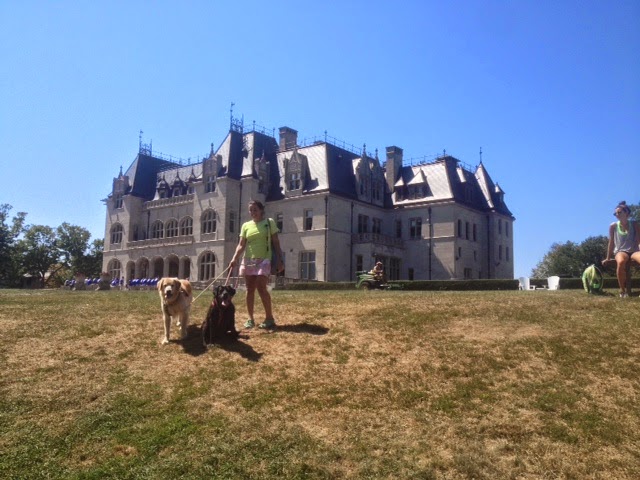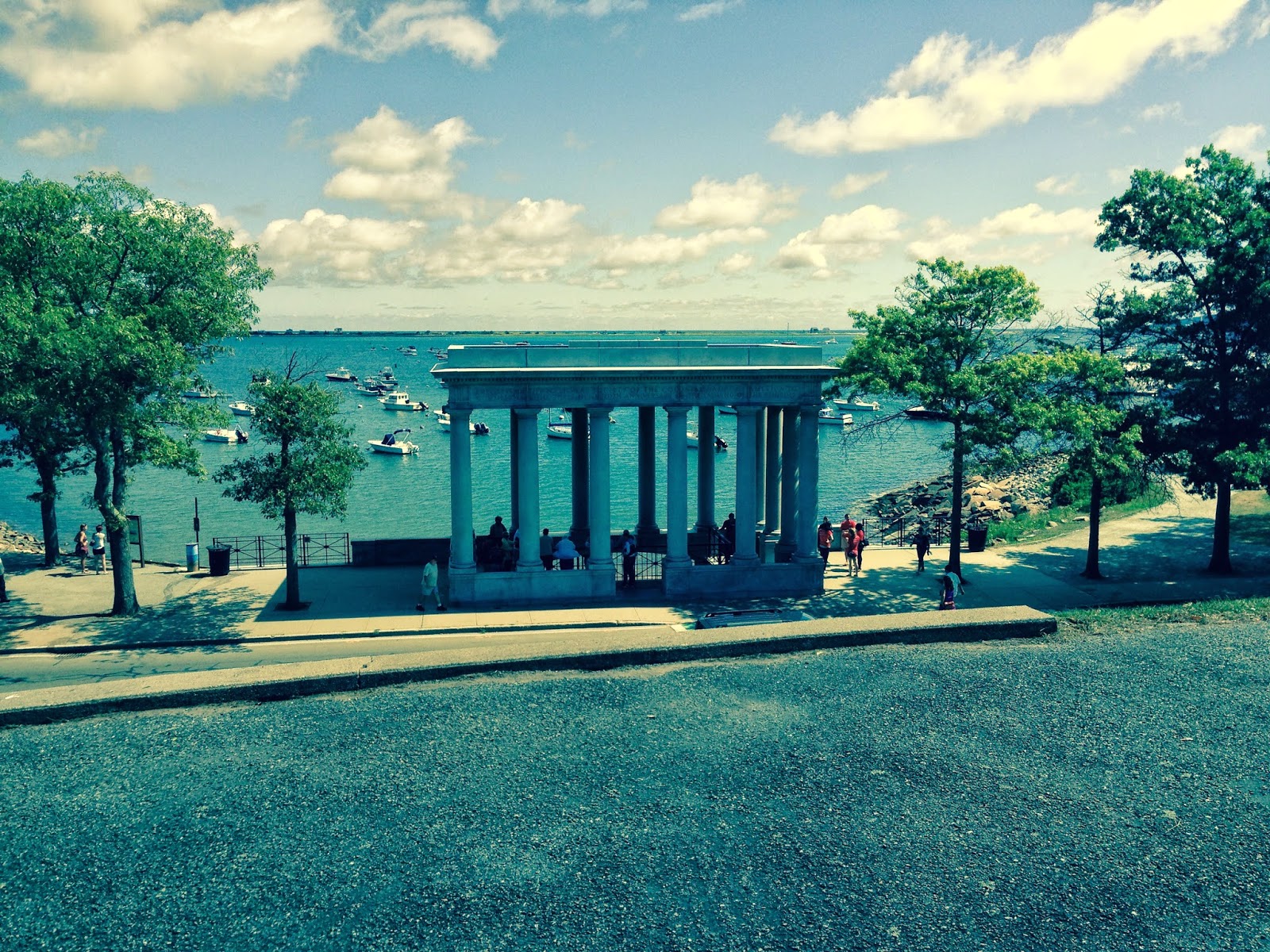 |
| Calypso docked forward of Two Fish in Judith Point |
 |
| Newport Harbor, passing tall ship |
I am trying desperately to catch up our blog. We are currently in Key Biscayne after the Miami show. Hopefully, I will have a few days to cover the rest of our journey north last August and September before the Annapolis show.
From the Worlds Fair Marina we had an easterly overnight sail through the Long Island Sound two rendezvous with Two Fish hull 4444 (sounds a bit redundant doesn't it?), and her owners, Gail and Jason at Judith's Point Marina. All kidding aside, Gail and Jason have always been so willing to help and share what they learn to the rest of our sailing community. There doesn't seem to be a single challenge they don't seem to conquer with flying colors. They deserve many Kudos, Maite and I say thank you! They were heading south after sailing as far north as Portland, Maine. After a nice visit, Maite had to attend a
funeral in New Orleans so we motored up to Providence RI to get close to easy air travel. We then sailed south and east spending a few days in Newport, RI. Newport was the playground of the rich and famous of New York and Boston at the turn of the 20th century. Their "vacation cottages" were astounding.
 |
| Vanderbilt Summer "Cottage" |
 |
| Newport Harbor |
Two days later we pulled anchor and headed due east for the Cape Cod Canal, passing Nantucket and
 Martha's Vineyard to Plymouth, Massachusetts. The east end of the Long Island sound can get choppy and windy quickly, so be prepared!
Martha's Vineyard to Plymouth, Massachusetts. The east end of the Long Island sound can get choppy and windy quickly, so be prepared!
 |
| Dinner time on Calypso |
I rarely get more attention than at dinner time. A favorite perch of our dogs is the top of the galley steps. From here they can see every move and properly supervise the preparation of their dinners (and ours). One of the primary A/C outlets is a foot off the floor at this location so that makes it THE prime real estate on board for our pups.
 |
| Plymouth Mainstreet today |
 |
| Plymouth Mainstreet 1627 |
Plymouth holds special meaning to me as I have always traced my lineage back to three members of the Mayflower Expedition (Isaac,
Mary and Remember Allerton). It is not an easy harbor to enter, with shallows
everywhere. As long as the markers are followed it is easy enough in daylight. The path is circuitous entering north of
town then abruptly turning south, following a peninsula for several miles
before turning back toward shore. The Mayflower never had the luxury of a
dredged channel and had to stay several miles off shore.
 |
| Plymouth Tour (learning the native perspective) |
I was a bit let down to learn that there are over 60 million people in the United States who claim to be descendants of the original Mayflower group even though half of them died the first winter. We had the distinct pleasure of a city tour
provided by one of the remaining Wampanoag Tribe members and his 10-year-old
nephew. Their slant on the first few years after the Pilgrims landed and the continuing politics between those of European dissent and the remaining native Americans tribes is a real eye opener. We followed up the tour with a trip to the Plymouth Plantation, a village reenactment complete with actors depicting
the state of Plymouth in 1627, along side an authentic Wampanoag village of the same
time period. For those that still believe that the history they were taught in school was unbiased or non politicized, I urge you to learn your history by traveling to the sites. There is nothing like it.
 |
| Allerton House left Pratt House mid photo |
 |
| Ed Pratt with his ancestor Phineas Pratt (Plymouth Colony) |
While at the Plymouth Plantation I was directed to the house of my ancestor Isaac Allerton and his second wife and two children. Surprisingly, another ancestor of mine Phineas Pratt was busy making mud plasters in the house next door. They would dig a big hole and mix equal parts straw and mud with water and pack it between sticks stacked between the framing timbers of their homes. He didn't look anything like me, although he thought he was better looking. We also toured the Plymouth graveyard
and went aboard a 1955 era Mayflower II replica that was sailed from Devon
England in 1957. At 106 feet LOA and 25 foot beam she just barely wider than
Calypso though 2 ½ times the length. After a tour below decks we realized how really good we have it with Calypso.
 |
| Maite and Ed aboard Mayflower II top deck amidships. Calypso in the background |
Plymouth will be commemorating the 400-year anniversary of the Mayflower landing in 2020. They are already hard at work
preparing. It promises to be an event!
I was amazed to find that there really was no first
Thanksgiving, just an uneasy coexistence between the Pilgrims and the Wampanoag... a mutual defense pact that was entered into because the Pilgrims
had guns and the local Wampanoag had been decimated by small pox in 1615 (brought
among them by European hunters). The Plymouth Wampanoag village was completely wiped out several years before the Mayflower arrived and the other neighboring Wampanoag tribes had there numbers so diminished that they could not
defend themselves against neighboring tribes.
 |
| Protective enclosure for Plymouth Rock |
 |
| Remaining Major Fragment of Plymouth Rock |
The story goes that the Pilgrims were celebrating
the harvest of their crops by shooting off their guns, and the Wampanoag braves
came running as per the mutual defense pact. When they learned there was no war,
and only an after harvest feast, they asked to stay but were turned away for
lack of food. The braves went into the forest and returned shortly with a dozen
deer to feed themselves and provide for the feast. William Bradford, the leader
of the Pilgrims and "Massasoit" the chief of the Wampanoag enjoyed a mutual
respect that maintained the peace, which ended when they passed on leaving
leadership to their sons. In the end the youngest son of Massasoit attempted to
lead an Indian revolt against all Massachusetts colonies (as it turns out with
good reason). This King Phillip War was brought to a close in 1672 when he was
hunted down, beheaded and his head placed on a spike that remained in the
Plymouth town square for 25 years. So much for good relations with the
neighbors!
 |
| What no first Thanksgiving? |
 Thanksgiving was actually an invention of Abraham
Lincoln when, near the end of the Civil War, he felt that a holiday was needed
to bring families back together. The current date of the third Thursday in
November was actually set by FDR in order to lengthen the Christmas buying
season between Thanksgiving and Christmas thereby boosting the economy. Man, no
Santa Claus, no Easter Bunny, and now no Thanksgiving turkey. What is up with
that!
Thanksgiving was actually an invention of Abraham
Lincoln when, near the end of the Civil War, he felt that a holiday was needed
to bring families back together. The current date of the third Thursday in
November was actually set by FDR in order to lengthen the Christmas buying
season between Thanksgiving and Christmas thereby boosting the economy. Man, no
Santa Claus, no Easter Bunny, and now no Thanksgiving turkey. What is up with
that!
Next post we will cover Block Island, Essex, Sandy Hook and on to Baltimore. See ya!


































